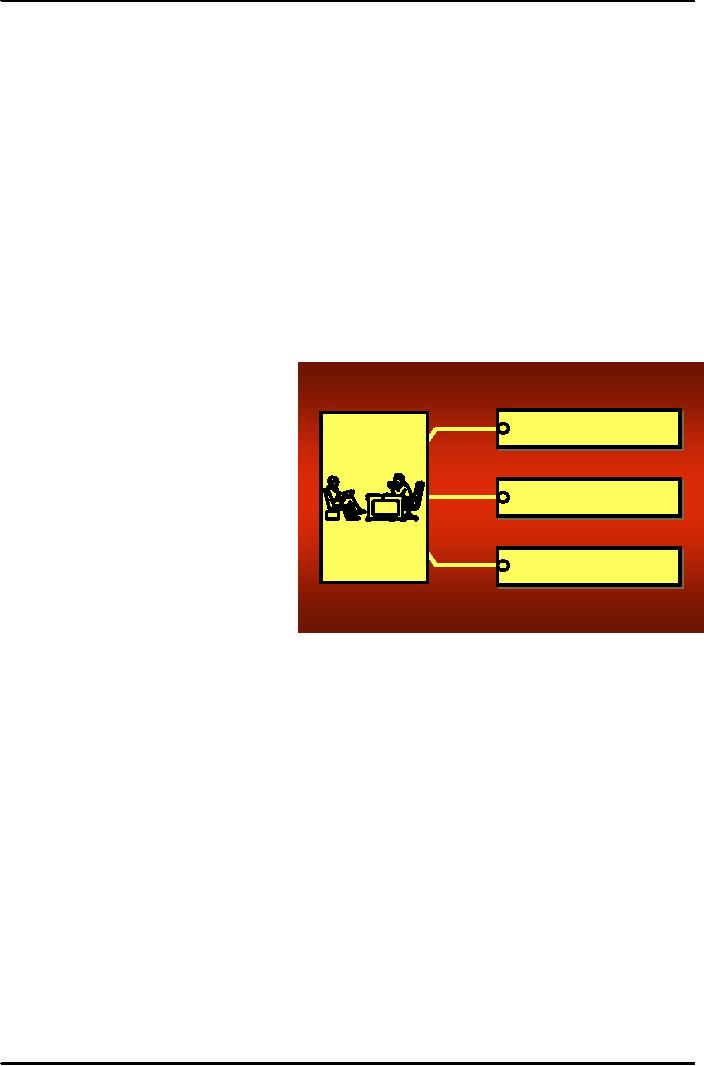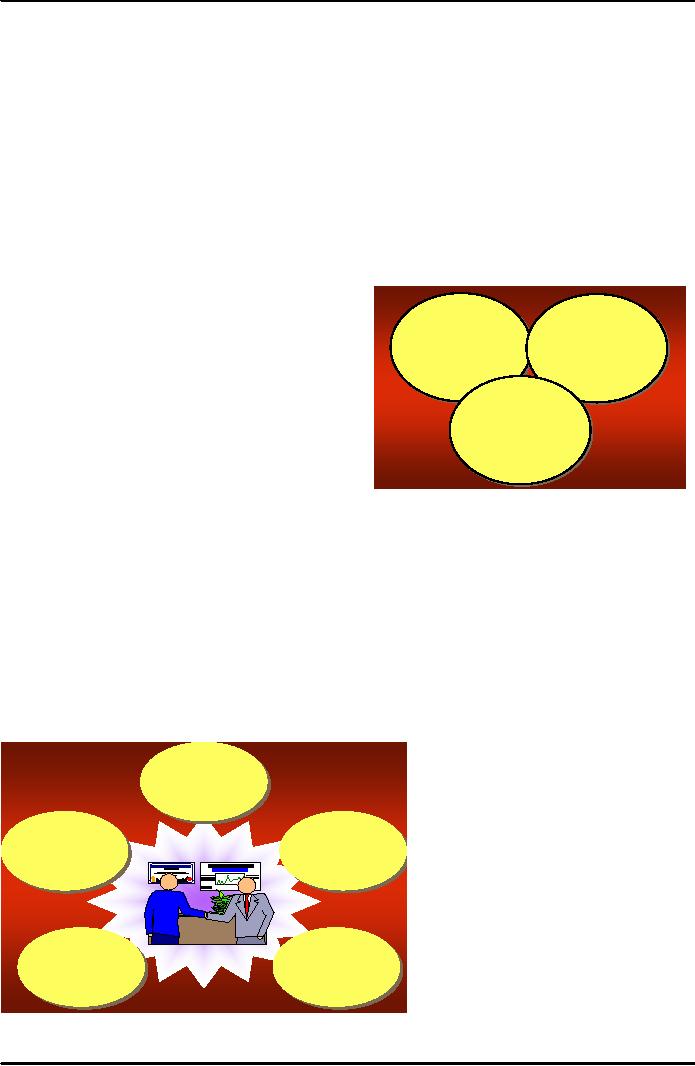 |

Principles
of Marketing MGT301
VU
Lesson
35
Lesson
overview and learning objectives:
Discuss
the role of a company's salespeople in
creating value for customers and
building customer
relationships.
Today, most companies use
salespeople to bring their company's
offering to the
consuming
or business publics. The salesperson's
role is a key one in the
organization. The
high
cost
of maintaining a sales force
means that management is
especially interested in how
to
efficiently
organize this vital
element.
PERSONAL
SELLING
A.
Personal selling
The
direct presentation of a product to a prospective customer by a
representative of the selling
organization
is termed as personal selling. Personal selling is
the personal communication
of
information
to persuade somebody to buy
something. Personal Selling occurs
when a company
representative
comes in direct contact with a customer
in order to inform a client
about a good or
service
to get a sale. Personal selling is
especially important for
business-to-business marketers
since
products and services are
complex and expensive. In
many companies, personal selling is
the
largest
single operating expense.
a.
The Nature of Personal
Selling
Selling
is one of the oldest professions in
the world. Today, most
salespeople are well-educated,
well-trained
professionals who work to
build and maintain long-term
relationships with customers.
They
build these relationships by listening to
their customers; assessing customer's
needs, and
organizing
the company's efforts to solve customer problems.
The term salesperson covers
a wide
variety
of positions and responsibilities. The
person can be:
1).
An inside order taker.
2).
An order getter (a great amount of
creative selling skills are demanded in
this position).
Personal
selling is likely to be emphasized in a
promotional mix when the
market is concentrated
or
the product has a high
unit value, is technical in nature, and
requires a demonstration. It is
also
useful
if the product can be tailored to an
individual customer's need, or the
product is in the
introductory
stage of the product life
cycle.
b.
The Role of the Sales
Force
Personal
selling is the interpersonal arm of the
promotion mix. Sales
people represent the
company
to the customer and act as
an intermediary linking the customer to
the company.
c.
Salespeople.
Salespeople
act for a company and
perform one of more of the
following: prospecting of new
business;
communicating with potential
and existing customers; servicing customers
and
information
gathering. Sales positions range from:
delivering product; taking orders;
building
goodwill
or educating customers; positions where technical knowledge is
required; and creative
selling.
d.
Sales management.
Sales
management involves the
analysis, planning, implementation
and control of sales
force
activities.
Advertising consists of one-way,
non-personal communication with
target customer
groups
while the personal selling
involves two-way, personal
communication between
salespeople
and
individual consumers. Personal selling
can be more effective than
advertising in more
180

Principles
of Marketing MGT301
VU
complex
selling situations. The role of personal
selling varies from company to
company. Some
firms
have no salespeople at all.
The sales force serves as a
critical link between a
company and its
customers.
The salesperson can
represent both buyer and
seller i.e.
1).
They represent the company
to the customer.
2).
They represent customers to the
company.
Salespeople
are becoming more market-focused and
customer-oriented.
1).The
old view was that
salespeople should be concerned with
sales and the
company
should
be concerned with profit.
2).
The new view is that
salespeople should be concerned with
more than just
producing
sales--they
must know how to produce customer
satisfaction and company
profit.
Personal
selling is performed by person-to-person
dialogue between prospective buyer
and the
seller
through direct human contact
for matching products to
needs. It involves developing
relationships
between buyer and the
seller to discover the needs
of the customers/buyers and
the
benefits
of the products that can
satisfy the needs of customer
can be communicated to
customer.
e.
The characteristics of personal
selling
Personal
selling is having flexibility of system
it provides one to one contact between
the buyers
and
sellers. It Identify specific
sales prospects the first
step in the selling process is
prospecting
identifying
qualified potential customers. Approaching
the right potential customers is crucial
to
selling
success. Direct contact with
the potential buyers provides opportunity
to demonstrate the
product
and to customers and to answer
the queries and questions of
the customers. Answer
questions
during the presentation step of
the selling process, the
salesperson tells the
product
"story"
to the buyer, showing how
the product will make or
save money. The salesperson
describes
the
product features but concentrates on
presenting customer benefits. Using a
need-satisfaction
approach,
the salesperson starts with
a search for the customer's
needs by getting the customer to
do
most of the talking. During
demonstration there can be certain
objections raised by the
customers,
which can be overcome at very
same time. Customers almost
always have objections
during
the presentation or when asked to
place an order. The problem
can be either logical or
psychological,
and objections are often
unspoken. In handling objections, the
salesperson should
use
a positive approach, seek out
hidden objections, asks the
buyer to clarify any objections,
take
objections
as opportunities to provide more
information, and turn the
objections into reasons
for
buying.
Every salesperson needs
training in the skills of handling
objections.
f.
Builds Relationships
The
principles of personal selling as just
described are transaction oriented--their
aim is to help
salespeople
close a specific sale with a
customer. But in many cases,
the company is not
seeking
simply
a sale: It has targeted a
major customer that it would
like to win and keep. The
company
would
like to show that it has the
capabilities to serve the customer
over the long haul in
a
mutually
profitable relationship.
Most
companies today are moving
away from transaction marketing, with its
emphasis on making
a
sale. Instead, they are
practicing relationship marketing, which
emphasizes maintaining
profitable
long-term
relationships with customers by creating superior
customer value and satisfaction.
They
are
realizing that when operating in maturing
markets and facing stiffer
competition, it costs a
lot
more
to wrest new customers from
competitors than to keep
current customers.
Today's
customers are large and
often global. They prefer
suppliers who can sell
and deliver a
coordinated
set of products and services
to many locations. They favor
suppliers who can
quickly
solve
problems that arise in their
different parts of the
nation or world, and who
can work closely
with
customer teams to improve
products and processes. For
these customers, the sale is
only the
beginning
of the relationship.
181

Principles
of Marketing MGT301
VU
Unfortunately,
some companies are not
set up for these developments.
They often sell
their
products
through separate sales forces,
each working independently to
close sales. Their
technical
people
may not be willing to lend
time to educate a customer.
Their engineering, design,
and
manufacturing
people may have the
attitude that "it's our
job to make good products
and the
salesperson's
to sell them to customers." However,
other companies are recognizing
that winning
and
keeping accounts requires more
than making good products
and directing the sales
force to
close
lots of sales. It requires a
carefully coordinated whole-company
effort to create value-laden,
satisfying
relationships with important
customers.
Relationship
marketing is based on the premise
that important accounts need
focused and ongoing
attention.
Studies have shown that
the best salespeople are
those who are highly
motivated and
good
closers, but more than
this, they are customer
problem solvers and
relationship builders.
Good
salespeople working with key
customers do more than call when
they think a customer
might
be ready to place an order.
They also study the
account and understand its problems.
They
call
or visit frequently, work
with the customer to help solve
the customer's problems and
improve
its
business, and take an interest in
customers as people.
g.
Basic Sales Tasks
Order
Getting:
It is
creative selling ad is
more
time consuming. It is used
for
??????
O
rd e r --G e
ttttiin g
selling
products to new
prospects
O
rd e r G e n g
(pioneers)
and to sell to
continuing
??????
customers
(account managers).
Some
times
telemarketing is used particularly
??????
O
rd e r --T a k
iin g
O
rd e r T a k n g
to
small accounts for seeking
customers,
??????
analyzing
their problems, Discover
solutions
and finally selling solutions
to
??????
S
u p p o rttiin
g
Suppor
ng
customers.
Order Taking:
This
task is
related
with very little creative
selling,
used
for Write up of orders,
for
checking
invoices for accuracy, to
assure
timely
order processing and may
use suggestive selling for
different problems that is supporting
the
customers
in acquiring solution for
problem.
h.
The advantages of personal
selling
The
advantages of personal selling over
the other promotion
tools...
�
It
can be adapted for
individual customers.
�
It
can be focused on prospective
customers.
�
It results in
the actual sale, while
most other forms of
promotion are used in moving
the
customer
closer to the sale.
i.
The disadvantages of personal
selling
�
The
major disadvantages of the
personal selling are:
�
Expensive
per contact
�
Many
sales calls may be needed to
generate a single
sale
�
Labor
intensive
�
It is
costly to develop and operate a
sales force.
�
It
may be difficult to attract high-caliber
people.
j.
Types of the personal selling
There
are two types of personal
selling:
182

Principles
of Marketing MGT301
VU
The
customers come to the
salespeople.
Mostly
involves retail-store selling. Most
salespeople fall into this
category.
The
salespeople go to the
customers.
Usually
represent producers or wholesaling middlemen
and sell to business users.
Some outside
selling
is relying more on telemarketing.
k.
Characteristics of Professional
Selling
Sales
reps engage in a total selling
job. Reps work closely
with customers. Sales reps
organize much
of
their own time and
effort. They often
experience role ambiguity
and role conflict.
l.
Contributions of Personal Selling to
Marketing:
Today,
most professional salespeople are
well-educated, well-trained men and
women who work to
build
long-term, value-producing relationships
with their customers. They
succeed not by taking
customers
in but by helping them
out--by
assessing
customer needs and solving
customer
problems.
Success in a selling environment
requires
P
ro d u c iin
g
M
e e tiin
g
P
ro d u c n g
M
eet ng
careful
teamwork among well-trained,
dedicated
S
a lle s
B
u ye r
Sa
es
B
u ye r
R
e ven u e
E
x p e c ta tiio n
s
R
e ven u e
E
x p e c ta t o n s
sales
professionals who are bent
on profitably
taking
care of their customers
P
ro v iid iin
g
P
ro v d n g
m.
Changing patterns in personal
selling
M
a rk e tp lla c
e
M
a rk e tp a c e
IIn fo rm a
tiio n
Traditionally,
personal selling has been a
face-to-
n
fo rm a t o n
face,
one-on-one situation. But
now new trends
and
patterns are emerging which
are:
Selling
Centers -- Team Selling
Systems
Selling
Global
Sales Teams
Relationship
Selling
Telemarketing
n.
Salesperson Attributes:
Salesperson
is an individual( like: Serving, and
Information gathering Salespeople,
sales
representatives,
account executives, sales
consultants, sales engineers,
agents, district
managers,
marketing
representatives, account development
reps, etc) acting for a
company by performing one
or
more of the following
activities.
Salesperson
is an individual acting
for
C
u s tto m e
rr--
Cus
om e
a
company by performing one or
more
O
rriie n tte d
O
en ed
of
the following activities:
Prospecting,
The first step in
the
selling
process is
prospecting--
L
iik a b lle
H
o n e s tt
Hones
L
kab e
identifying
qualified
potential
customers.
Approaching the right
potential
customers is crucial to selling
success.
Than during the
presentation
step
of the selling process,
the
D
e p e n d a b lle
C
o m p e tte n
tt
salesperson
tells the product "story"
to
Dependab
e
Com
pe en
the
buyer, showing how the
product
will
make or save money.
The
salesperson
describes the product
features but concentrates on presenting customer
benefits.
183

Principles
of Marketing MGT301
VU
Using
a need-satisfaction
approach, the
salesperson starts with a
search for the customer's
needs by
getting
the customer to do most of the
talking. To be more effective in
this process sales
person
should
possess certain attributes, they
should be honest should be
competent to demonstrate the
products
and handle objections should be customer oriented so
tat customers can be
satisfied,
should
possess the skills so that
potential customers are ready to
listen about the offered
products.
184
Table of Contents:
- PRINCIPLES OF MARKETING:Introduction of Marketing, How is Marketing Done?
- ROAD MAP:UNDERSTANDING MARKETING AND MARKETING PROCESS
- MARKETING FUNCTIONS:CUSTOMER RELATIONSHIP MANAGEMENT
- MARKETING IN HISTORICAL PERSPECTIVE AND EVOLUTION OF MARKETING:End of the Mass Market
- MARKETING CHALLENGES IN THE 21st CENTURY:Connections with Customers
- STRATEGIC PLANNING AND MARKETING PROCESS:Setting Company Objectives and Goals
- PORTFOLIO ANALYSIS:MARKETING PROCESS,Marketing Strategy Planning Process
- MARKETING PROCESS:Analyzing marketing opportunities, Contents of Marketing Plan
- MARKETING ENVIRONMENT:The Company’s Microenvironment, Customers
- MARKETING MACRO ENVIRONMENT:Demographic Environment, Cultural Environment
- ANALYZING MARKETING OPPORTUNITIES AND DEVELOPING STRATEGIES:MIS, Marketing Research
- THE MARKETING RESEARCH PROCESS:Developing the Research Plan, Research Approaches
- THE MARKETING RESEARCH PROCESS (Continued):CONSUMER MARKET
- CONSUMER BUYING BEHAVIOR:Model of consumer behavior, Cultural Factors
- CONSUMER BUYING BEHAVIOR (CONTINUED):Personal Factors, Psychological Factors
- BUSINESS MARKETS AND BUYING BEHAVIOR:Market structure and demand
- MARKET SEGMENTATION:Steps in Target Marketing, Mass Marketing
- MARKET SEGMENTATION (CONTINUED):Market Targeting, How Many Differences to Promote
- Product:Marketing Mix, Levels of Product and Services, Consumer Products
- PRODUCT:Individual product decisions, Product Attributes, Branding
- PRODUCT:NEW PRODUCT DEVELOPMENT PROCESS, Idea generation, Test Marketing
- NEW PRODUCT DEVELOPMENT:PRODUCT LIFE- CYCLE STAGES AND STRATEGIES
- KEY TERMS:New-product development, Idea generation, Product development
- Price the 2nd P of Marketing Mix:Marketing Objectives, Costs, The Market and Demand
- PRICE THE 2ND P OF MARKETING MIX:General Pricing Approaches, Fixed Cost
- PRICE THE 2ND P OF MARKETING MIX:Discount and Allowance Pricing, Segmented Pricing
- PRICE THE 2ND P OF MARKETING MIX:Price Changes, Initiating Price Increases
- PLACE- THE 3RD P OF MARKETING MIX:Marketing Channel, Channel Behavior
- LOGISTIC MANAGEMENT:Push Versus Pull Strategy, Goals of the Logistics System
- RETAILING AND WHOLESALING:Customer Service, Product Line, Discount Stores
- KEY TERMS:Distribution channel, Franchise organization, Distribution center
- PROMOTION THE 4TH P OF MARKETING MIX:Integrated Marketing Communications
- ADVERTISING:The Five M’s of Advertising, Advertising decisions
- ADVERTISING:SALES PROMOTION, Evaluating Advertising, Sales Promotion
- PERSONAL SELLING:The Role of the Sales Force, Builds Relationships
- SALES FORCE MANAGEMENT:Managing the Sales Force, Compensating Salespeople
- SALES FORCE MANAGEMENT:DIRECT MARKETING, Forms of Direct Marketing
- DIRECT MARKETING:PUBLIC RELATIONS, Major Public Relations Decisions
- KEY TERMS:Public relations, Advertising, Catalog Marketing
- CREATING COMPETITIVE ADVANTAGE:Competitor Analysis, Competitive Strategies
- GLOBAL MARKETING:International Trade System, Economic Environment
- E-MARKETING:Internet Marketing, Electronic Commerce, Basic-Forms
- MARKETING AND SOCIETY:Social Criticisms of Marketing, Marketing Ethics
- MARKETING:BCG MATRIX, CONSUMER BEHAVIOR, PRODUCT AND SERVICES
- A NEW PRODUCT DEVELOPMENT:PRICING STRATEGIES, GLOBAL MARKET PLACE